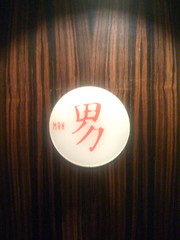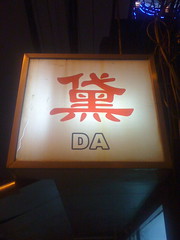Character Check!
by John Pasden
31 Jan 2009
On the historic eve of Obama’s inauguration, I just happened to run into these two signs, both on Tongren Lu (铜仁路).


Notice anything strange? (And for extra points, do you know where I saw these? If you’re a foreigner living in Shanghai, there’s a good chance you’ve seen them.)
Like this:
Like Loading...

John Pasden
John is a Shanghai-based linguist and entrepreneur, founder of AllSet Learning.
On the eve of Obama’s inauguration, you say?
Let me see: the one on the left is a toilet door sign advising black men to stand two inches further back from the urinals, and the one on the right was put up by a Republican to insinuate that Obama is really a woman.
How did I do?
The correct pinyin for the one on the right is dai4, and it’s a kind of black face paint. But I don’t see the connection to Obama. Is it some kind of minstrel show thing?
Reminds me, yesterday the wife and I were walking near the Gubei Carrefour and saw a sign for a massage place that was marked “指庄” rather than “指压.” Thought that was pretty funny… their 点 slipped.
应该写”男“, 第二个拼音不对。
Is the second one kind of referring to a “black era”..?
I didn’t mean to imply that the signs are at all related to Obama’s inauguration; that’s just when I saw them.
Anyway, Pete and Erick are right. IS this a real variant form of 男? Note that the bottom component is similar to 勿 (but one stroke less) and not 力, as one would expect.
It apparently is a variant, according to the Dictionary of Variant Characters issued by the Taiwan Ministry of Education, where it’s sourced to Tang-era inscriptions. Incidentally, 田 over 勿 is another variant.
There’s also one seal character here (L33857) that uses components that could have led to a variant in later scripts.
zhwj,
Great links! I forgot about those great resources. Your assistance is much appreciated.
Have you ever seen a 男 variant like this one on a (semi-)official sign in China?
First time I’ve seen it. But bathroom signs are supposed to be vehicles for self-expression, right?
It looks like the sign-maker got himself a copy of 中国书法大字典 and simply copied one of the entries: the image above is really similar to Ouyang Xun’s version on page 1049 of 新编中国书法大字典 (sorry for the crappy image; I cropped it out of a pirated PDF).
It’s not Mural bar is it??
If 黛 is on the girls’ toilets, I guess it is a reference to 黛玉, the female lead from the 红楼梦, and arguably a Chinese exemplar of femininity. Basically a literary way of saying “girl”.
I like that ‘man’ character, especially for a bathroom. It really does look like a man peeing!
I have a question now about another weird character choice I’ve seen: I was looking at a Mainland rock band’s blog (Fusion’s, to be specific) and there was an entry about a song one of the members had written, but it said “一手歌” instead of “一首歌.” That made me curious, why would people write it that way? I mean, I know that “手” and “首” have the same sound, but “首” is the measure word when it comes to songs. Can someone explain for me?
I agree with Lu, though that’s really gross!
@maxiewawa: Nope!
@rob: Heh… nice try, but the one on the right was hanging outside some kind of beauty parlor or something (didn’t look too closely).
@hobielover: Probably just a typo. It happens (especially online!).
John: If it’s a typo, which I would understand and it had crossed my mind, why would the typo repeat as “一手DEMO”? Of course, I’ve come up with much worse in typed song lyrics. (That’s probably one of the reasons why I actually buy CDs, since that way I don’t have to go on the Online lyrics.)